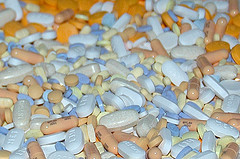Resent Aspect of Mouth Dissolving Tablet - An Overview
Recently pharmaceutical preparations used for elderly patients have been investigated to improve the treatment compliances and quality of life of patients. Recent advances in Novel Drug Delivery System (NDDS) aims to enhance safety and efficacy of drug molecule by formulating a convenient dosage form for administration and to achieve better patient compliance. One such approach is "Mouth Dissolving Tablet" The concept of Mouth Dissolving Drug Delivery System emerged from the desire to provide patient with conventional mean of taking their medication. Difficulty in swallowing (Dysphagia) is a common problem of all age groups, especially elderly and pediatrics, because of physiological changes associated with these groups of patients.
The whole 19 pages article is available for download here.
Other categories that experience problems using conventional oral dosage forms includes are the mentally ill, uncooperative and nauseated patients, those with conditions of motion sickness, sudden episodes of allergic attack or coughing. Some times it may be difficult to swallow conventional products due to unavailability of water. These problems led to the development of novel type of solid oral dosage form called "Mouth Dissolving Tablets". This tablet disintegrates instantaneously when placed on tongue, releasing the drug that dissolves or disperses in the saliva. On placing mouth-dissolving tablet in the mouth, saliva serves to rapidly dissolve the dosage form. The saliva containing the dissolved or dispersed medicament is then swallowed and the drug is absorbed in the normal way. Some drugs are absorbed from the mouth, pharynx and esophagus as the saliva passes down into the stomach & it may produce rapid onset of action. In such a cases Bioavailability of drug is significantly greater than those observed from conventional tablet dosage form.19 The dispersible tablets allows dissolution or dispersion in water prior to administration but the Mouth Dissolving Tablet instead of dissolving or disintegrating in water is expected to dissolve or disintegrate in oral cavity without drinking water. The disintegrated mass then slides down smoothly along the esophagus along with saliva.
Introduction
Oral routes of drug administration have wide acceptance up to 50-60% of total dosage forms. Solid dosage forms are popular because of ease of administration, accurate dosage, self-medication, pain avoidance and most importantly the patient compliance1. The most popular solid dosage forms are being tablets and capsules; one important drawback of this dosage forms for some patients, is the difficulty to swallow2 . Drinking water plays an important role in the swallowing of oral dosage forms. Often times people experience inconvenience in swallowing conventional dosage forms such as tablet when water is not available, in the case of the motion sickness (kinetosis) and sudden episodes of coughing during the common cold, allergic condition and bronchitis3. For these reason, tablets that can rapidly dissolve or disintegrate in the oral cavity have attracted a great deal of attention. Orodispersible tablets are not only indicated for people who have swallowing difficulties, but also are ideal for active people4. Fast dissolving tablets are also called as mouth-dissolving tablets, melt-in mouth tablets, Orodispersible tablets, rapimelts, porous tablets, quick dissolving etc. Fast dissolving tablets are those when put on tongue disintegrate instantaneously releasing the drug which dissolve or disperses in the saliva5. The faster the drug into solution, quicker the absorption and onset of clinical effect. Some drugs are absorbed from the mouth, pharynx and esophagus as the saliva passes down into the stomach6. In such cases, bioavailability of drug is significantly greater than those observed from conventional tablets dosage form. The advantage of mouth dissolving dosage forms are increasingly being recognized in both, industry and academics7. Their growing importance was underlined recently when European pharmacopoeia adopted the term " Orodispersible tablet" as a tablet that to be placed in the mouth where it disperses rapidly before swallowing. According to European pharmacopoeia, the ODT should disperse/disintegrate in less than three minutes. The basic approach in development of FDT is the use of superdisintegrants like cross linked carboxymethyl cellulose (croscarmellose), sodium starch glycolate (primogel, explotab), polyvinylpyrollidone (polyplasdone) etc, which provide instantaneous disintegration of tablet after putting on tongue, their by release the drug in saliva. The bioavailability of some drugs may be increased due to absorption of drug in oral cavity and also due to pregastric absorption of saliva containing dispersed drugs that pass down into the stomach. More ever, the amount of drug that is subjected to first pass metabolism is reduced as compared to standard tablet.
The whole 19 pages article is available for download here.

